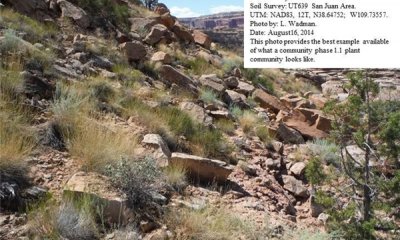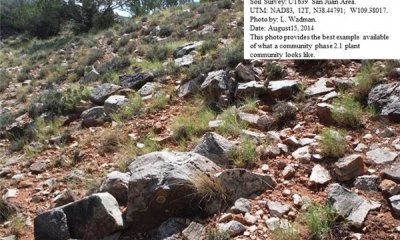
Talus Slope (Blackbrush-Shadscale)
Scenario model
Current ecosystem state
Select a state
Management practices/drivers
Select a transition or restoration pathway
- Transition T1A More details
- Transition T2A More details
-
No transition or restoration pathway between the selected states has been described
Target ecosystem state
Select a state
Description
This Reference State describes the various biotic communities that are expected to be found on this ecological site under natural conditions. Two distinct phases are present and are described below as Wet and Dry Phases.
The Wet Phase has a scattered overstory of Utah juniper with small amount of two-needle pinyon. A wide array of shrubs including Mormon tea, blackbrush, spiny hopsage, and Mexican cliffrose dominate the shrub layer. A well developed grass layer is often present with Indian ricegrass, salina wildrye and James galleta occurring most often. This phase nearly always has a north, northeast or east aspect. It is normally at higher elevations and found in higher precipitation zones or where additional run-on moisture occurs. Its soils typically have higher Available Water Holding Capacity's (AWC) and often have fewer coarse fragments found within the soil profile.
The Dry Phase has little or no Utah juniper or two-needle pinyon present. Primary shrubs include blackbrush, shadscale, Castle Valley saltbush and Mormon tea. Herbaceous species are rare with minor amounts of Indian ricegrass and James galleta usually present. On more sandy soils, spike and mesa dropseed may be present. This phase typically has a south, southwest or west aspect. It is normally at lower elevations and found in lower precipitation zones where little or on additional run-on moisture occurs. Its soils typically have lower Available Water Holding Capacity's (AWC) and often have large amounts of coarse fragments within the soil profile.
The reference state is self-sustaining and resistant to change due to good natural resilience to its natural disturbances. The primary natural disturbance mechanisms are wildlife population densities which can affect the shrub layer composition and weather fluctuations.
Definitions:
Reference State: Natural plant communities as influenced by latitude, elevation, aspect, precipitation (including run-on moisture), soil texture and depth, and the percent of coarse fragments found within the soil profile.
Indicators: These communities are highly variable with a wide array of species present specific of the physical site conditions.
Feedbacks: Natural fluctuations in weather patterns that allow for native species to be self-sustaining and prevent the establishment of invasive species.
At-risk Community Phase: All communities are at risk when native plants are stressed and conditions are created that may allow invasive plants to establish.
Trigger: The establishment of invasive plant species.
Submodel
Description
This Current Potential State describes the various biotic communities that are expected to be found on this ecological site under current conditions. Two distinct phases are present and are described below as Wet and Dry Phases. Both phases now contain invasive species with Russian thistle, various mustard species and knapweed occurring most often.
The Wet Phase has a scattered overstory of Utah juniper with small amount of two-needle pinyon. A wide array of shrubs including Mormon tea, blackbrush, spiny hopsage, and Mexican cliffrose dominate the shrub layer. A well developed grass layer is often present with Indian ricegrass, salina wildrye and James galleta occurring most often. Russian thistle and annual mustard are common invasive species. This phase nearly always has a north, northeast or east aspect. It is normally at higher elevations and found in higher precipitation zones or where additional run-on moisture occurs. Its soils typically have higher Available Water Holding Capacity's (AWC) and often have fewer coarse fragments found within the soil profile.
The Dry Phase has little or no Utah juniper or two-needle pinyon present. Primary shrubs include blackbrush, shadscale, Castle Valley saltbush and Mormon tea. Herbaceous species are rare with minor amounts of Indian ricegrass and James galleta usually present. On more sandy soils, spike and mesa dropseed may be present. Russian thistle and knapweed are commonly occurring invasive species. This phase typically has a south, southwest or west aspect. It is normally at lower elevations and found in lower precipitation zones where little or on additional run-on moisture occurs. Its soils typically have lower Available Water Holding Capacity's (AWC) and often have large amounts of coarse fragments within the soil profile.
The reference state is self-sustaining and resistant to change due to good natural resilience to its natural disturbances. The primary natural disturbance mechanisms are wildlife population densities which can affect the shrub layer composition and weather fluctuations.
Definitions:
Reference State: Natural plant communities as influenced by latitude, elevation, aspect, precipitation (including run-on moisture), soil texture and depth, and the percent of coarse fragments found within the soil profile.
Indicators: These communities are highly variable with a wide array of species present specific of the physical site conditions.
Feedbacks: Natural fluctuations in weather patterns that allow for native species to be self-sustaining and prevent the establishment of invasive species.
At-risk Community Phase: All communities are at risk when native plants are stressed and conditions are created that may allow invasive plants to establish.
Trigger: The establishment of invasive plant species.
Submodel
Mechanism
This transitional pathway occurs when any combination of heavy wildlife browsing and long periods without fire allow invasive species to occupy the site. Invasive species, however, appear to travel along road corridors and will invade adjacent sites even with healthy plant populations present.
Mechanism
This transitional pathway occurs when any combination of heavy wildlife browsing recent fire reduce blackbrush and other fire sensitive species allow invasive species to occupy the site. Invasive species, however, appear to travel along road corridors and will invade adjacent sites even with healthy plant populations present.
Model keys
Briefcase
Add ecological sites and Major Land Resource Areas to your briefcase by clicking on the briefcase (![]() ) icon wherever it occurs. Drag and drop items to reorder. Cookies are used to store briefcase items between browsing sessions. Because of this, the number of items that can be added to your briefcase is limited, and briefcase items added on one device and browser cannot be accessed from another device or browser. Users who do not wish to place cookies on their devices should not use the briefcase tool. Briefcase cookies serve no other purpose than described here and are deleted whenever browsing history is cleared.
) icon wherever it occurs. Drag and drop items to reorder. Cookies are used to store briefcase items between browsing sessions. Because of this, the number of items that can be added to your briefcase is limited, and briefcase items added on one device and browser cannot be accessed from another device or browser. Users who do not wish to place cookies on their devices should not use the briefcase tool. Briefcase cookies serve no other purpose than described here and are deleted whenever browsing history is cleared.
Ecological sites
Major Land Resource Areas
The Ecosystem Dynamics Interpretive Tool is an information system framework developed by the USDA-ARS Jornada Experimental Range, USDA Natural Resources Conservation Service, and New Mexico State University.






